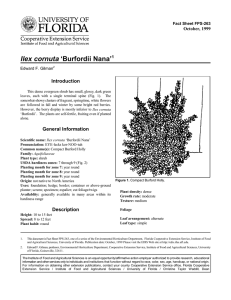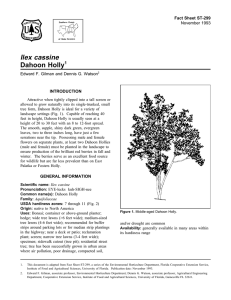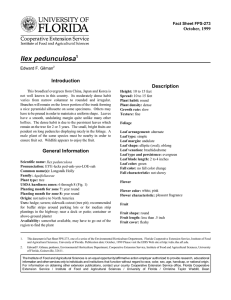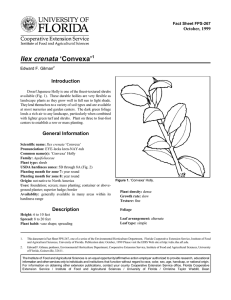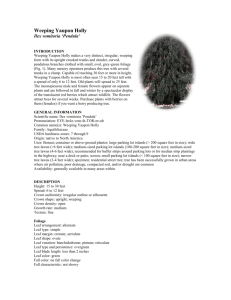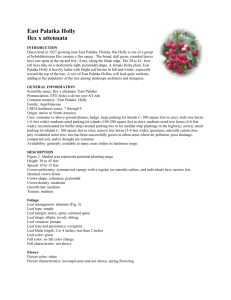Ilex cornuta ‘Burfordii’ Burford Holly Fact Sheet ST-301 1
advertisement
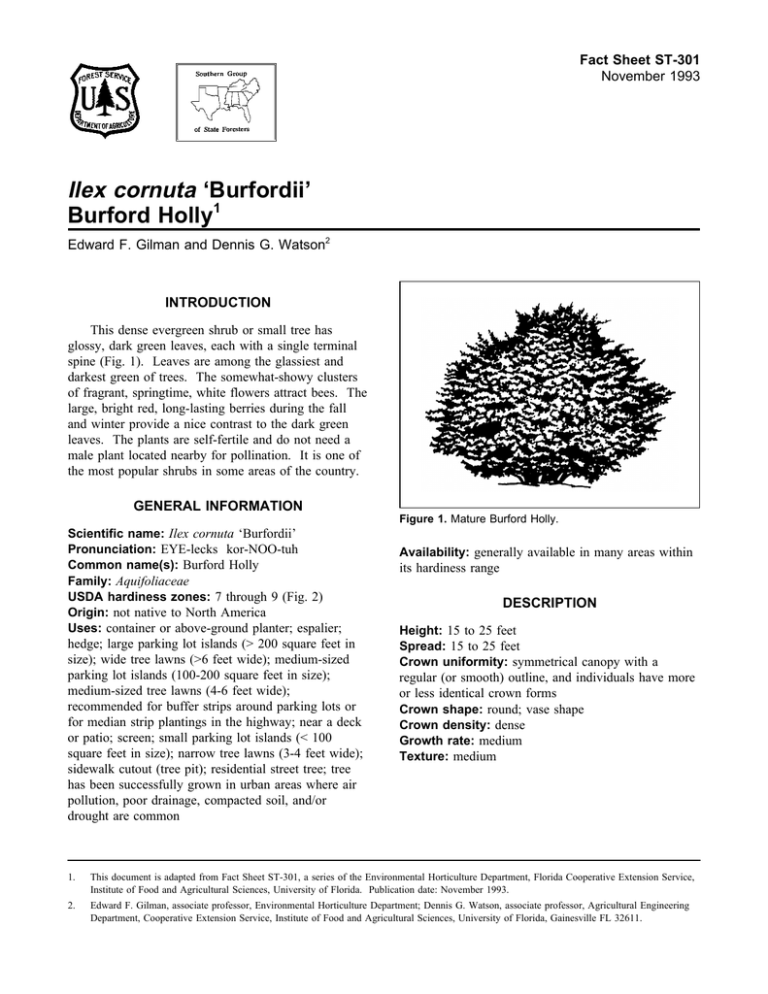
Fact Sheet ST-301 November 1993 Ilex cornuta ‘Burfordii’ Burford Holly1 Edward F. Gilman and Dennis G. Watson2 INTRODUCTION This dense evergreen shrub or small tree has glossy, dark green leaves, each with a single terminal spine (Fig. 1). Leaves are among the glassiest and darkest green of trees. The somewhat-showy clusters of fragrant, springtime, white flowers attract bees. The large, bright red, long-lasting berries during the fall and winter provide a nice contrast to the dark green leaves. The plants are self-fertile and do not need a male plant located nearby for pollination. It is one of the most popular shrubs in some areas of the country. GENERAL INFORMATION Figure 1. Mature Burford Holly. Scientific name: Ilex cornuta ‘Burfordii’ Pronunciation: EYE-lecks kor-NOO-tuh Common name(s): Burford Holly Family: Aquifoliaceae USDA hardiness zones: 7 through 9 (Fig. 2) Origin: not native to North America Uses: container or above-ground planter; espalier; hedge; large parking lot islands (> 200 square feet in size); wide tree lawns (>6 feet wide); medium-sized parking lot islands (100-200 square feet in size); medium-sized tree lawns (4-6 feet wide); recommended for buffer strips around parking lots or for median strip plantings in the highway; near a deck or patio; screen; small parking lot islands (< 100 square feet in size); narrow tree lawns (3-4 feet wide); sidewalk cutout (tree pit); residential street tree; tree has been successfully grown in urban areas where air pollution, poor drainage, compacted soil, and/or drought are common Availability: generally available in many areas within its hardiness range DESCRIPTION Height: 15 to 25 feet Spread: 15 to 25 feet Crown uniformity: symmetrical canopy with a regular (or smooth) outline, and individuals have more or less identical crown forms Crown shape: round; vase shape Crown density: dense Growth rate: medium Texture: medium 1. This document is adapted from Fact Sheet ST-301, a series of the Environmental Horticulture Department, Florida Cooperative Extension Service, Institute of Food and Agricultural Sciences, University of Florida. Publication date: November 1993. 2. Edward F. Gilman, associate professor, Environmental Horticulture Department; Dennis G. Watson, associate professor, Agricultural Engineering Department, Cooperative Extension Service, Institute of Food and Agricultural Sciences, University of Florida, Gainesville FL 32611. Ilex cornuta ‘Burfordii’ -- Burford Holly Page 2 Figure 2. Shaded area represents potential planting range. Foliage Trunk and Branches Leaf arrangement: alternate (Fig. 3) Leaf type: simple Leaf margin: entire; terminal spine Leaf shape: elliptic (oval); oblong Leaf venation: pinnate Leaf type and persistence: evergreen Leaf blade length: 2 to 4 inches Leaf color: green Fall color: no fall color change Fall characteristic: not showy Trunk/bark/branches: bark is thin and easily damaged from mechanical impact; droop as the tree grows, and will require pruning for vehicular or pedestrian clearance beneath the canopy; routinely grown with, or trainable to be grown with, multiple trunks; not particularly showy; no thorns Pruning requirement: needs little pruning to develop a strong structure Breakage: resistant Current year twig color: green; gray Current year twig thickness: medium Flower Flower color: white Flower characteristics: inconspicuous and not showy; spring flowering Fruit Fruit Fruit Fruit Fruit Fruit shape: round length: < .5 inch covering: fleshy color: red characteristics: attracts birds; no significant litter problem; persistent on the tree; showy Culture Light requirement: tree grows in part shade/part sun; tree grows in full sun Soil tolerances: clay; loam; sand; acidic; alkaline; extended flooding; well-drained Drought tolerance: high Aerosol salt tolerance: moderate Soil salt tolerance: moderate Ilex cornuta ‘Burfordii’ -- Burford Holly Page 3 for low-maintenance landscapes which receive little or no irrigation or fertilizer after trees are established. Once the tree reaches 10 or 15 feet tall, growth rate slows. ‘Burfordii Nana’ makes a better shrub than ‘Burfordii’ due to a slower growth rate and smaller leaves. Propagation is by cuttings only. Pests Burford Holly can be plagued with severe infestations of tea scale. Diseases No diseases are of major concern. Figure 3. Foliage of Burford Holly. Other Roots: surface roots are usually not a problem Winter interest: tree has winter interest due to unusual form, nice persistent fruits, showy winter trunk, or winter flowers Outstanding tree: not particularly outstanding Invasive potential: little, if any, potential at this time Verticillium wilt susceptibility: not known to be susceptible Pest resistance: long-term health usually not affected by pests USE AND MANAGEMENT Although typically pruned for formal hedges, the large form and gracefully drooping branches of Burford Holly make it ideal for unpruned natural plantings or as a specimen for spacious areas and large buildings. There are much better plants for pruning into formal hedges. Burford Holly can also be trained as an attractive vase-shaped multi-stemmed small tree. Trees trained in this fashion often have a thick crown comprised of many branches and small-diameter trunks. Burford Holly should be grown and used in this fashion more often. Growing best in rich, well-drained, slightly acid soil, Burford Holly does well in full sun or part shade. However, flowering and subsequent fruiting is reduced in shady locations. Burford Holly is drought-tolerant and easy to grow once established. It is well suited
